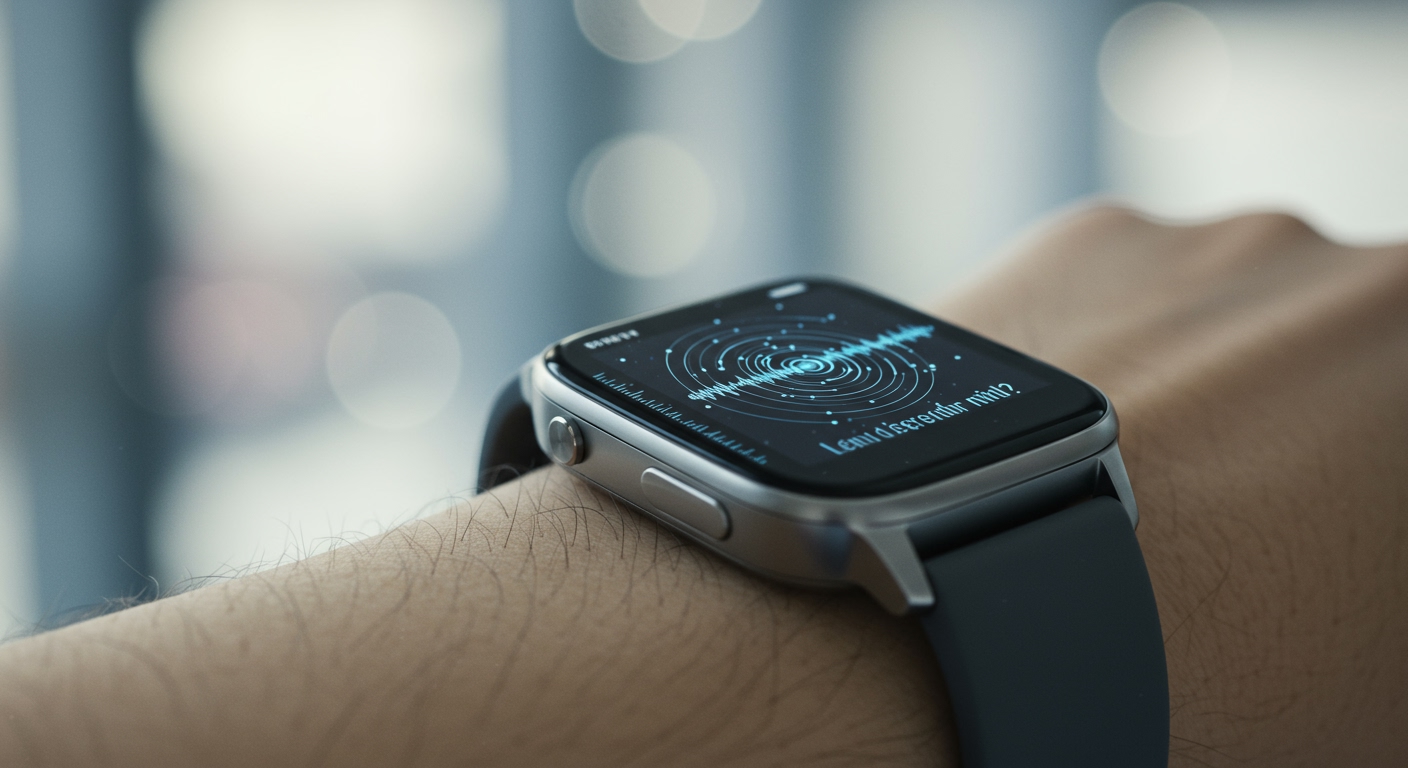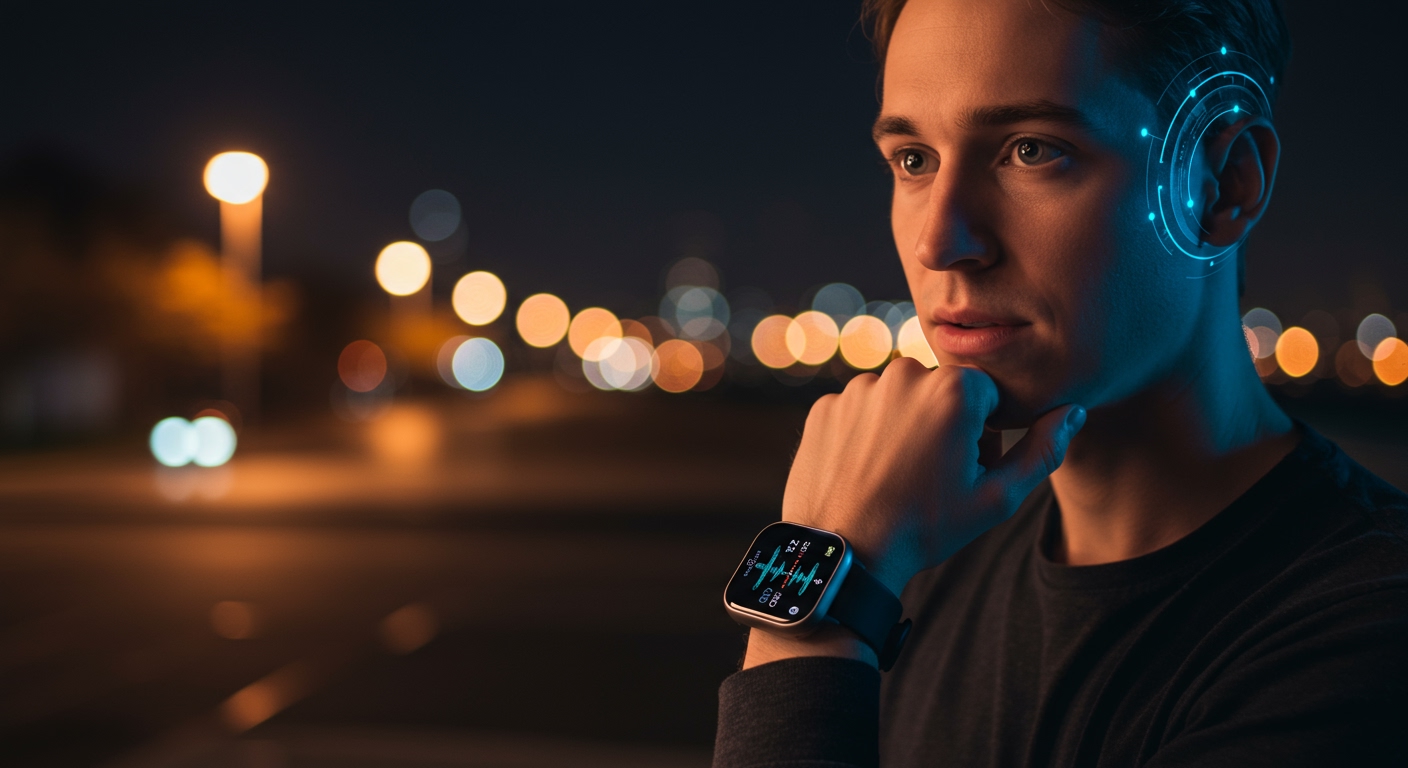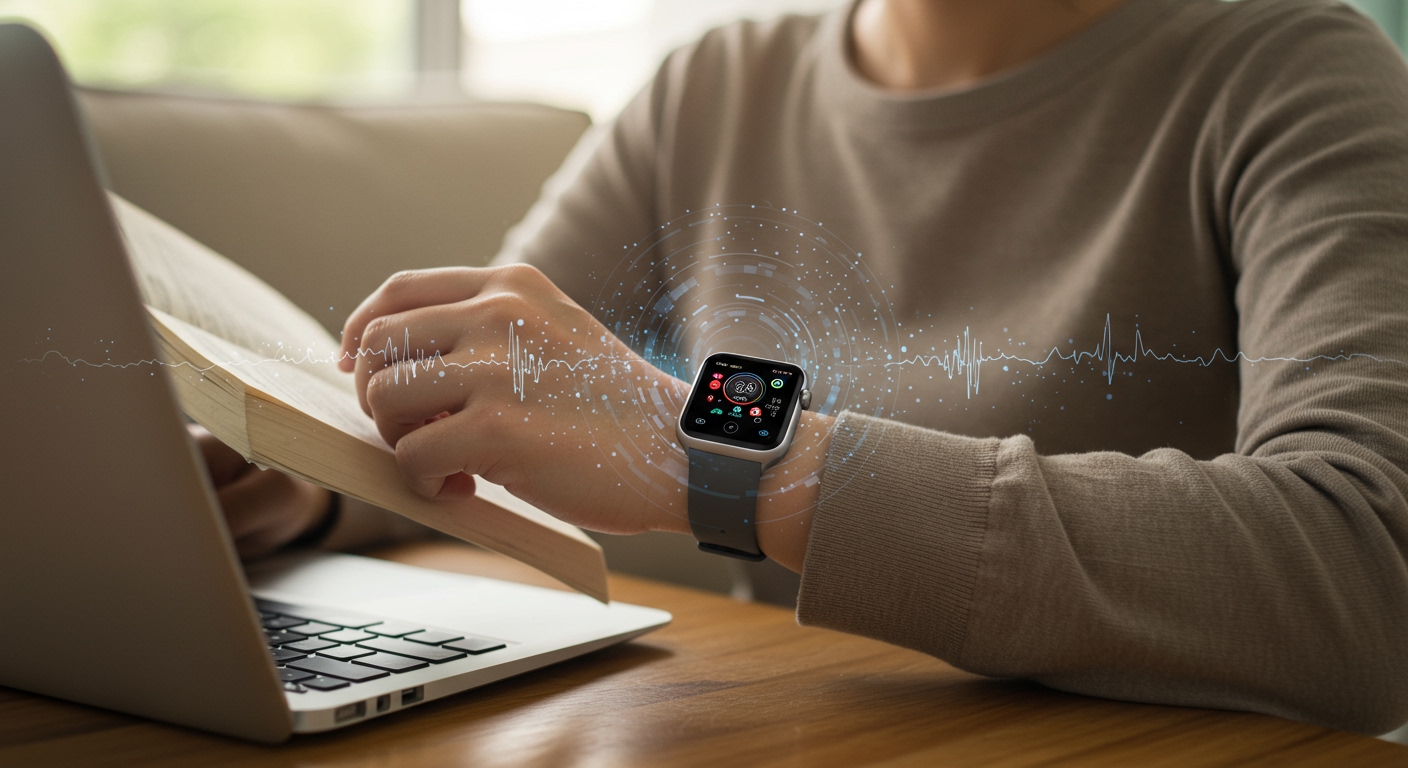Is Your Smartwatch Reading Your Mind? The Neuro-Tech Revolution and Daily Life
Is Your Smartwatch Reading Your Mind? The Neuro-Tech Revolution and Daily Life
Explore how neuro-tech is evolving, from smartwatches monitoring brain signals to potential mind-reading capabilities, and its profound impact on daily life and privacy.
Key Points
- Smartwatches currently monitor physiological data, not directly read complex thoughts.
- Neuro-tech is rapidly advancing, exploring brain-computer interfaces (BCIs) and muscle signal interpretation.
- Wearable neuro-devices aim to translate neural or muscular signals into actionable data for health, wellness, and device control.
- Current applications include monitoring stress, improving focus, and potentially aiding in early detection of neurological conditions.
- Ethical concerns regarding privacy, data security, potential misuse, and cognitive liberty are critical considerations for neuro-tech development.
- The future holds enhanced human-computer interaction and personalized health interventions, necessitating careful societal and regulatory oversight.
The Dawn of Neuro-Wearables
%%HIGHLIGHT_START%%For years, smartwatches have become a staple in our daily routines, effortlessly tracking steps, monitoring heart rates, and even analyzing sleep patterns. These devices have become virtual extensions of our bodies, quietly gathering data that empowers our health and wellness choices. However, a far more profound transformation is now quietly underway, pushing the very boundaries of what this technology can perceive and transmit: the neuro-tech revolution.%%HIGHLIGHT_END%%
This evolving field delves into the intricate workings of the human brain and nervous system, seeking to bridge the gap between biological signals and digital interfaces. The question ‘Is your smartwatch reading your mind?’ once a far-fetched notion from science fiction, is now prompting serious discussion among researchers, ethicists, and tech enthusiasts alike. While current smartwatches are not capable of telepathy, advancements in neuro-sensing technologies are bringing us closer to a future where our thoughts, intentions, and emotional states could be interpreted by the very devices we wear on our wrists.
This article explores the current state of neuro-tech in wearables, distinguishing between present capabilities and future possibilities. It delves into the underlying science, the applications emerging across various sectors, and the critical ethical considerations that arise as we venture into this unprecedented territory of mind-machine interaction.
We are on the cusp of a revolution where technology will not just augment our physical abilities but begin to interface directly with our minds, challenging our understanding of self and privacy.
Understanding Neuro-Tech: Beyond the Screen
Neuro-technology encompasses any technology that directly interacts with the brain, either by recording brain activity or by stimulating it. While traditional smartwatches focus on physiological signals like heart rate variability, skin temperature, and accelerometer data, neuro-wearables aim to tap into the electrical and chemical signals generated by our neurons and muscles.
The primary method for non-invasive brain activity measurement is electroencephalography (EEG), which detects electrical impulses on the scalp. While full EEG setups are bulky, miniaturized versions are making their way into consumer devices. Beyond brainwaves, electromyography (EMG) measures the electrical activity produced by skeletal muscles, which can provide insights into subtle movements, intentions, and even unspoken commands.
The difference between traditional biometric data and neural data is significant. Heart rate tells you about your physical exertion; neural data, particularly brainwave patterns, can potentially reveal cognitive states, emotional responses, or even early indicators of neurological conditions. This leap from physical monitoring to cognitive interpretation is what makes the neuro-tech revolution so transformative.

Current Capabilities: Sensing the Subtleties
While direct mind-reading remains in the realm of science fiction, current neuro-wearables are already capable of sensing and interpreting subtle signals that provide insights into our internal states.
Brainwave Monitoring in Smart Devices
Some advanced smartwatches and headbands currently on the market integrate simplified EEG sensors. These devices are primarily used for wellness applications, such as monitoring stress levels, tracking meditation progress, and analyzing sleep quality. By detecting specific brainwave frequencies (e.g., alpha waves for relaxation, beta waves for alertness), they can provide users with feedback on their mental state.
For instance, certain rings and headbands can guide users through meditation exercises by giving real-time feedback on their focus levels, helping them achieve a more relaxed state. While they don’t decipher specific thoughts, they can infer generalized states of mind like calm, focus, or agitation based on the overall electrical patterns of brain activity. This data empowers individuals to better manage their mental well-being and understand how their daily activities impact their cognitive state.
Muscle Activity and Intent
Beyond brainwaves, smartwatches are increasingly incorporating advanced EMG sensors. These sensors pick up the minute electrical signals generated when our muscles contract. Companies are exploring how these signals, particularly from the wrist and forearm, can be translated into digital commands. Imagine being able to control a drone, type on a virtual keyboard, or navigate a menu simply by making tiny, imperceptible hand or finger movements, or even just thinking about them.
The underlying principle is that our brains send signals to our muscles even before we consciously perform a large movement. By detecting these subtle pre-movements or ‘neural impulses’ at the muscle level, wearables could anticipate user intent, transforming interaction with digital interfaces. This technology could revolutionize everything from gaming to augmented reality, offering a new, more intuitive form of human-computer interaction.
The Leap to “Mind Reading”: Fact vs. Fiction
The sensational phrase ‘mind reading’ often conjures images of telepathy, where thoughts are directly extracted from one mind and transferred to another. In the context of neuro-tech, ‘mind reading’ is a highly nuanced concept. It does not imply access to complex, semantic thoughts or memories in their entirety.
Instead, neuro-tech aims to decode patterns of brain activity that correlate with specific intentions, commands, or emotional states. For example, researchers might train an algorithm to recognize the brain patterns associated with the intention to move a cursor left or right, or the neural signatures linked to feelings of joy or sadness. This is pattern recognition and interpretation, not direct thought extraction.
The complexity of the human brain, with its billions of neurons and trillions of connections, makes true ‘mind reading’ extraordinarily challenging. Thoughts are not stored as discrete, easily decodable packets. They emerge from dynamic, distributed activity across vast neural networks. Current technology is best at identifying broad states or predicting simple, volitional actions based on robust and repeatable neural signals, often collected in controlled environments. Translating a nuanced thought, a memory, or a dream into text or actionable data remains a significant hurdle, though research continues to push these boundaries.
Applications of the Neuro-Tech Revolution
The potential applications of advanced neuro-wearables extend far beyond basic fitness tracking, promising profound impacts on various aspects of daily life.
Healthcare and Wellness
One of the most promising areas for neuro-tech is healthcare. Wearable neuro-sensors could provide continuous, passive monitoring for early detection of neurological conditions such as epilepsy, Parkinson’s disease, or even early signs of dementia. By tracking subtle changes in brainwave patterns or muscle tremors, these devices could alert users or caregivers to potential issues, allowing for earlier intervention.
Furthermore, in mental health, neuro-wearables could offer personalized insights into stress, anxiety, and depressive states. They could guide mindfulness practices, provide biofeedback for anxiety reduction, or even deliver targeted neural stimulation (transcranial direct current stimulation or tDCS, though this is more advanced and less common in consumer wearables) to improve mood or cognitive function. For individuals recovering from stroke or injury, EMG-enabled smartwatches could assist in rehabilitation by providing feedback on muscle activation and promoting motor learning.

Enhanced Human-Computer Interaction
Imagine interacting with your smart home devices, virtual reality environments, or even your car, using only subtle intentions. Neuro-wearables are poised to revolutionize how we control technology. Instead of relying on touchscreens, voice commands, or physical buttons, users could execute commands with minimal, intuitive neural or muscular signals.
This could lead to truly immersive augmented and virtual reality experiences, where actions within the digital world mirror natural human thought and intent. For gaming, this opens up new dimensions of control, making experiences more intuitive and responsive. For professionals, it could mean faster, more seamless interaction with complex software and machinery, enhancing productivity and reducing cognitive load.
Workplace Productivity and Focus
In the professional sphere, neuro-wearables could help individuals optimize their cognitive states. By monitoring brainwave patterns associated with focus and fatigue, these devices could provide gentle alerts when concentration wanes, suggest breaks, or recommend techniques to regain focus. This personalized feedback could lead to improved productivity, reduced burnout, and a better understanding of individual peak performance times.
For learning and training, neuro-tech could adapt educational content based on a learner’s engagement or cognitive load, ensuring information is delivered at the optimal pace and complexity. This adaptive learning environment promises a more efficient and effective educational experience, tailored to each individual’s unique cognitive profile.
Ethical Implications and Privacy Concerns
The advent of neuro-tech brings with it a complex web of ethical dilemmas and privacy concerns. Neural data is perhaps the most intimate and sensitive form of personal information. Unlike credit card numbers or even health records, it directly pertains to our thoughts, emotions, and cognitive processes. The potential for misuse, exploitation, or even manipulation of this data is profound.
Key questions emerge: Who owns your neural data? How will it be secured from hackers? Could insurance companies use it to deny coverage based on predisposition to neurological conditions? Could employers use it to assess an employee’s emotional state or attention span? The ‘right to cognitive liberty’ – the fundamental freedom to control one’s own mind and mental privacy – becomes a critical principle in this new landscape. Without robust regulatory frameworks and strong ethical guidelines, there is a risk of unprecedented invasions of privacy and potential for discrimination based on neural profiles.
Furthermore, the potential for ‘neuro-enhancement’ raises concerns about equity and access. If certain neuro-technologies provide significant cognitive advantages, who will have access to them, and what implications will this have for societal fairness? These are not hypothetical questions but urgent considerations that require proactive engagement from policymakers, researchers, and the public.

The Road Ahead: What the Future Holds
The future of neuro-tech in wearables promises continued miniaturization, increased accuracy, and more sophisticated algorithms for decoding neural signals. We can expect these devices to become even more seamlessly integrated into our daily lives, moving beyond dedicated smartwatches to smart clothing, eyeglasses, or even embedded sensors in our environments.
The collaboration between neuroscientists, engineers, and ethicists will be crucial to navigate this frontier responsibly. As the technology matures, it will necessitate a global conversation about data governance, personal autonomy, and the very definition of human experience in an increasingly connected world. The goal should be to harness the transformative power of neuro-tech to enhance human well-being and capabilities, while rigorously safeguarding individual rights and societal values.
Conclusion: A New Frontier for Humanity
The idea of a smartwatch reading your mind is evolving from a sci-fi fantasy into a nuanced reality. While current devices offer preliminary insights into mental states and intentions, the rapid pace of neuro-technological advancement suggests a future where our wearable tech could truly interface with our neural pathways in unprecedented ways. This revolution holds immense promise for advancements in healthcare, human-computer interaction, and personal well-being.
However, with great power comes great responsibility. The ethical considerations surrounding neural data privacy, security, and the potential for societal impact are paramount. As we stand on the precipice of this new frontier, it is essential that the development and deployment of neuro-wearables are guided by a commitment to human-centric design, transparency, and a robust framework of ethical principles to ensure that this profound technological leap benefits all of humanity.
Frequently Asked Questions
Can smartwatches truly read my thoughts today?
No, current smartwatches and consumer wearables cannot directly ‘read’ or decipher your complex thoughts or memories like telepathy. They can, however, detect and interpret subtle physiological and neural signals that correlate with certain generalized mental states (like stress or focus) or simple intentions for movement. The term ‘mind-reading’ in this context refers to decoding patterns of brain activity, not direct access to your subjective thoughts.
What kind of brain data can current wearables collect?
Today’s neuro-wearables primarily collect electroencephalography (EEG) data, which measures electrical activity on the scalp, and electromyography (EMG) data, which measures electrical activity in muscles. EEG data is used to infer general brain states such as relaxation, alertness, or sleep stages. EMG data, especially from the wrist or forearm, can be used to detect subtle muscle movements or pre-movements that indicate a user’s intent to interact with a digital device.
What are the biggest ethical concerns with neuro-tech?
The biggest ethical concerns with neuro-tech revolve around data privacy and security. Neural data is highly sensitive and personal, raising questions about who owns this data, how it is protected from breaches, and how it might be used by companies, governments, or other entities. There are also concerns about potential misuse, such as for surveillance, manipulation, or discrimination based on an individual’s neural profile. The concept of ‘cognitive liberty’ – the right to mental privacy and self-determination – is becoming increasingly important.








